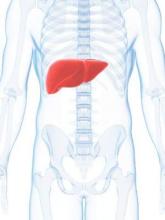Chronic nonmalignant liver disease is on the rise in the United States in part because of increasing incidence of nonalcoholic fatty liver disease, according to a report published online in Clinical Gastroenterology and Hepatology.
Nearly 2 million deaths each year in the United States are linked to chronic liver disease and recently, the overall mortality rate has been increasing, wrote Dr. Prowpanga Udompap and colleagues in the division of gastroenterology and hepatology at Stanford (Calif.) University.
Chronic liver disease can be caused by a number of factors, such as hepatitis B and hepatitis C infection, alcohol consumption, diabetes, and metabolic syndrome. “In general, HBV infection tends to have a large burden in resource-limited countries and nonalcoholic fatty liver disease (NAFLD) in more established economies, whereas HCV infection and alcohol use are prevalent throughout,” the researchers wrote.
In the United States, chronic liver disease and cirrhosis are the 12th leading cause of death, claiming more than 36,000 lives in 2013 – representing 1.4% of all deaths that year – and the prevalence of cirrhosis is estimated to be approximately 0.27% (Clin Gastroenterol Hepatol. 2015, Aug 17. doi: 10.1016/j.cgh.2015.08.015).
The mortality rate from chronic liver disease and cirrhosis has increased from 9.4 deaths per 100,000 in 1999 to 11.5 in 2013, but the increase is particularly evident in individuals aged 55-64 years, which the authors attributed to aging of the HCV birth cohort.
“Projection studies have estimated that although the incidence of new HCV infection in the United States decreased over time, the number of individuals living with advanced fibrosis and cirrhosis will rise as the birth cohort of baby boomers with HCV infection grows older and their duration of infection reaches long enough time for their liver fibrosis to have progressed to cirrhosis,” the authors wrote.
While estimates for the prevalence of nonalcoholic fatty liver disease in the United States vary significantly because of differences in test sensitivities, a study based on NHANES data suggested the incidence of ultrasound-diagnosed nonalcoholic hepatic steatosis (NASH) could be as high as 34%.
Patients with NASH have a higher risk of progression to cirrhosis than do patients with nonalcoholic fatty liver disease; one study found an incidence of 3.1% for incident cirrhosis over a 7.6-year follow-up of patients with NASH.
“NASH is quickly becoming a major etiology in liver transplantation in the United States, and it may soon become the most common indication,” the authors wrote.
Alcoholic liver disease is another global health problem, and in 2013, 7% of American adults were estimated to have an alcohol use disorder.
Given 30%-45% of individuals with chronic alcohol use disorder will develop alcoholic hepatitis at some stage, alcoholic liver disease is the second most common indication for liver transplantation in the United States and even this is likely an underestimation of the true burden of alcohol liver disease, the authors wrote.
Other less common contributors to the burden of chronic liver disease in this country include chronic hepatitis B infection, metabolic liver diseases such as hereditary hemochromatosis, and rarer autoimmune and cholestatic liver diseases such primary biliary cirrhosis and autoimmune hepatitis.
No conflicts of interest were disclosed.


